In 2025, Supercars teams honour the official Indigenous Round with bold liveries adapted from original artworks by Indigenous artists.
Each design is a vivid expression of culture and storytelling, bringing culture and connection to the track as these powerful machines race around Hidden Valley.
Dive into the stories behind these stunning designs.
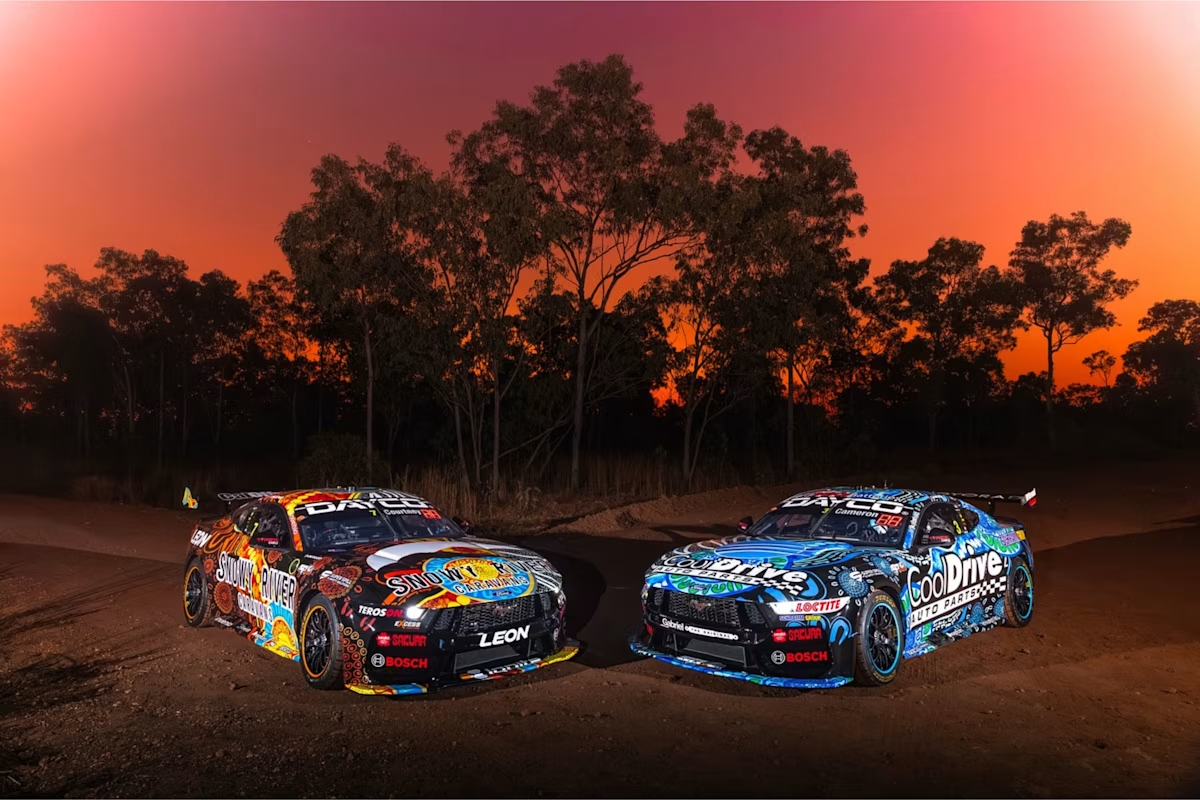
Blanchard Racing Team
Drivers - JAMES COURTNEY #7 and AARON CAMERON #3
Ford Mustang GT
artist - Presten warren
The stunning liveries adorning Blanchard Racing’s #3 and #7 Ford Mustangs — two halves of a unified artwork — have been created by Kokatha, Mirning, Wirangu, Arabana and Dieri artist Presten Warren.
Raised in Ceduna and inspired to paint from a young age by his mother and grandmother to honour and preserve culture, Presten’s work blends traditional practice with contemporary expression. Since launching his practice in 2022, he has won numerous awards and garnered international interest, becoming a passionate advocate and mentor for the next generation of Aboriginal artists.
Titled ‘Two Tribes’ the piece is shaped by the artist’s connection to both the desert and saltwater peoples of South Australia. The design is split across the two cars with each standing boldly in its own right, one brought to life with the rich desert ochres of the inland desert Country and the other in the deep ocean blues of saltwater Country.
A river runs through the centre, linking these landscapes with a visual thread that speaks to shared origins, interconnection, and movement. Together, they become a single story told in two parts, brought to life through motion, colour, and elements of Country.
At its heart, the work is about unity, love, and the beauty that forms when two worlds meet. It is a celebration of his blended heritage — the balance between land and sea, tradition and modern life, cultural roots and contemporary expression.
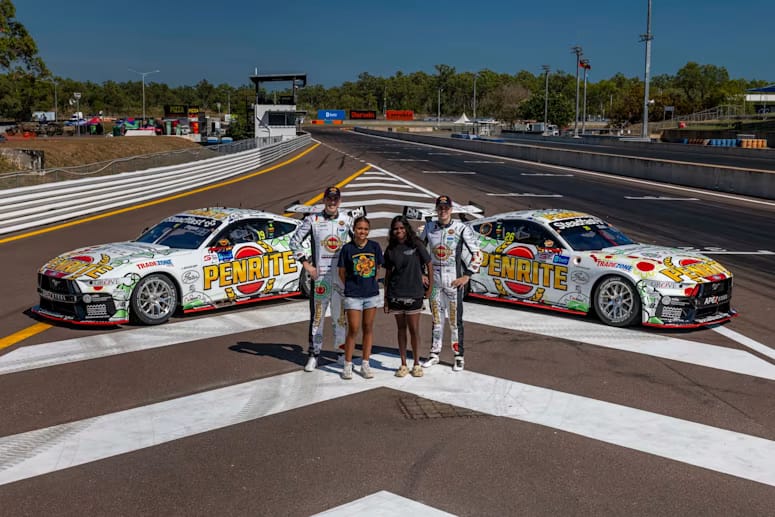
Grove Racing
DRIVERs - Matt Payne #19 and Kai Allen #26
ford mustang GT
artists - Ella & Jamelia – MITS students
The striking livery that adorns both Penrite Mustangs is the result of a collaborative artwork by two talented Indigenous high school students. Their individual designs have been woven together to create a powerful visual story of identity, culture, and connection.
Ella and Jamelia, currently in Years 10 and 11, attend the Melbourne Indigenous Transition School (MITS), a place that provides a home away from home for students from remote communities. Their artworks reflect their experiences here and are grounded in the theme of connection — to culture, to Country, and to all Aboriginal people.
A number of key symbols tell this story. Footprints represent the journeys of young Aboriginal people from all corners of the country, brought together by a shared pursuit of education and opportunity. Purple symbols illustrate the gathering of students at MITS — a place where stories are shared, friendships formed, and connections deepened.
The ‘U’ shapes symbolise Aboriginal people sitting in a circle, yarning — a cultural practice of storytelling and knowledge exchange. At the centre of the design sits the MITS logo, representing the nurturing environment where learning, growth and connection flourish.
Cross-stitch patterns highlight the interwoven nature of cultural knowledge — passed down through generations via these sacred storytelling circles.
Reflecting on her design, Jamelia said, “My artwork represents the culture of aboriginal people and how every MITS mob are all connected in some way.”
Shell motifs are also featured on the livery, honouring the ocean and its deep cultural significance for Torres Strait Islander people.
As Ella explained, “I wanted to include the Torres Strait Islander patterns because they have been through the same thing us Aboriginal people have been through, the connection between us Aboriginals and Torres Strait Islanders is a bond that was created ages ago with each culture helping and always looking out for another in important times.”

team 18
DRIVERS - Anton De Pasquale #18 and David Reynolds #20
Chevrolet Camaro ZL1
artist - Leah cummins
Designed by Leah Cummins, this year’s liveries for Team 18 are united by a powerful theme of progress and shared purpose, with each artwork bringing its own distinct energy to the track for 2025.
Leah, a proud Mayi woman from North-Western Queensland, draws inspiration from her cultural identity and ancestral stories, channelling these influences into vibrant artworks that celebrate her connection to Country, while educating and sharing the richness of First Nations culture.
Kangaroo tracks are used uniquely in both pieces to symbolise strength, determination and forward momentum—always moving ahead, never looking back.
Driven by Anton De Pasquale, the #18 Camaro features striking artwork that flows across the car’s body in trademark DeWalt yellow and black, intertwining traditional motifs with modern engineering and raw performance.
The artwork adopts a softened version of the Tradie Energy colour palette on David Reynolds’ #20 Camaro, blending musky pink tones into a halftone of vibrant silver for a fresh and dynamic interpretation of the same story.
Together, these pieces reflect a collective journey toward a common goal, showing individual paths converging at the centre; united by purpose and the winning spirit that drives every lap.
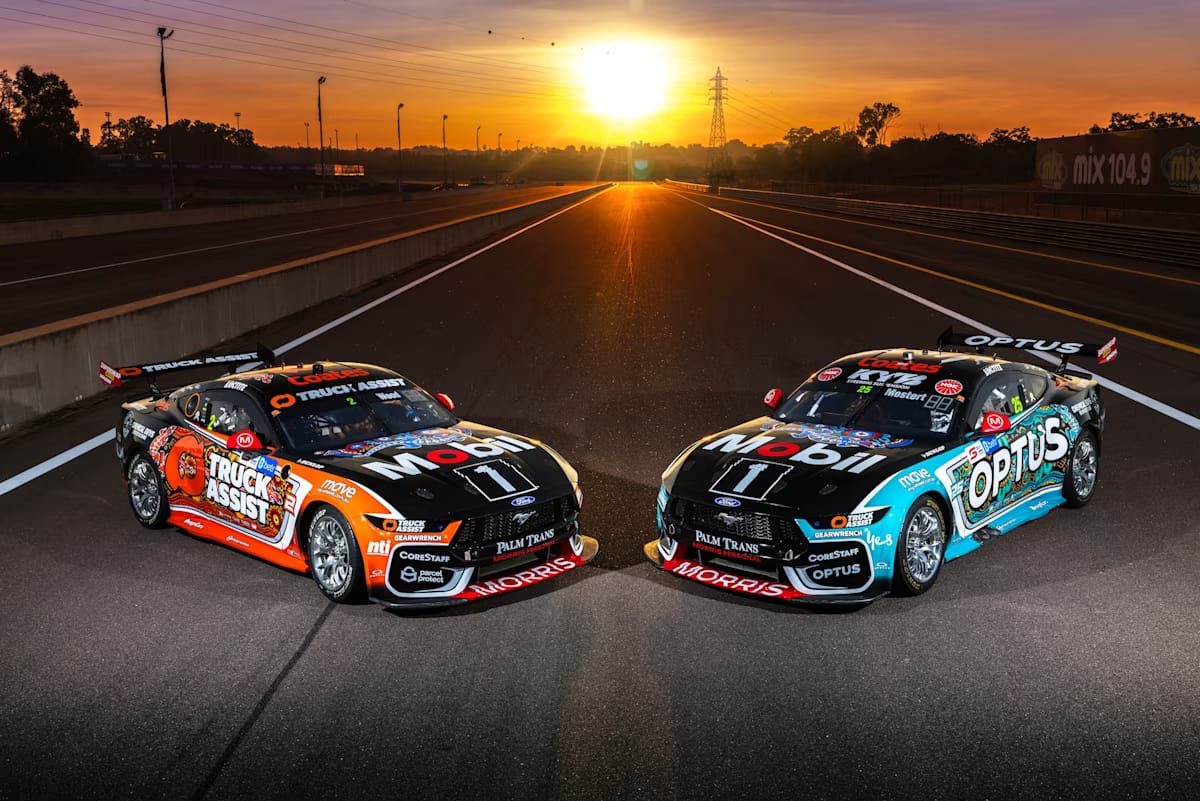
WALKINSHAW ANDRETTI UNITED
Drivers - CHAZ MOSTERT #25 and RYAN WOOD #2
Ford Mustang GT
Artist - Monica Taylor
Badimia Yamatji artist Monica Taylor, who hails from Mount Magnet in Western Australia, brings personal memory and cultural resonance to her livery design for Walkinshaw Andretti.
The artwork centres on the Australian goanna (Bungarra), an animal of great significance to Indigenous Australians, both as a vital food source and as a powerful presence in cultural rituals and Dreamtime stories.
The piece created for cars #2 and #25 draws on Monica’s childhood memories of her grandmother taking part in bungarra hunts—it tells the story of how she witnessed different family groups working together to track the bungarra by following their footprints in the desert sand to their burrows, where they were dug out, cooked on coals, and shared as a reward for their teamwork.
Known for their incredible speed, goannas can sprint short distances on their hind legs in pursuit of prey. This powerful trait is what inspired the artist to choose the goanna as a symbol for the Walkinshaw Andretti United Ford Mustangs.
This spirit of unity and purpose flows through the design, which explores the parallels between traditional hunting practices and the dynamics of a modern race team.
Just as trust, loyalty, and instinct are essential during a hunt, the same qualities are crucial within a racing team, where success depends on the seamless collaboration of every member, each playing their part with precision and purpose.
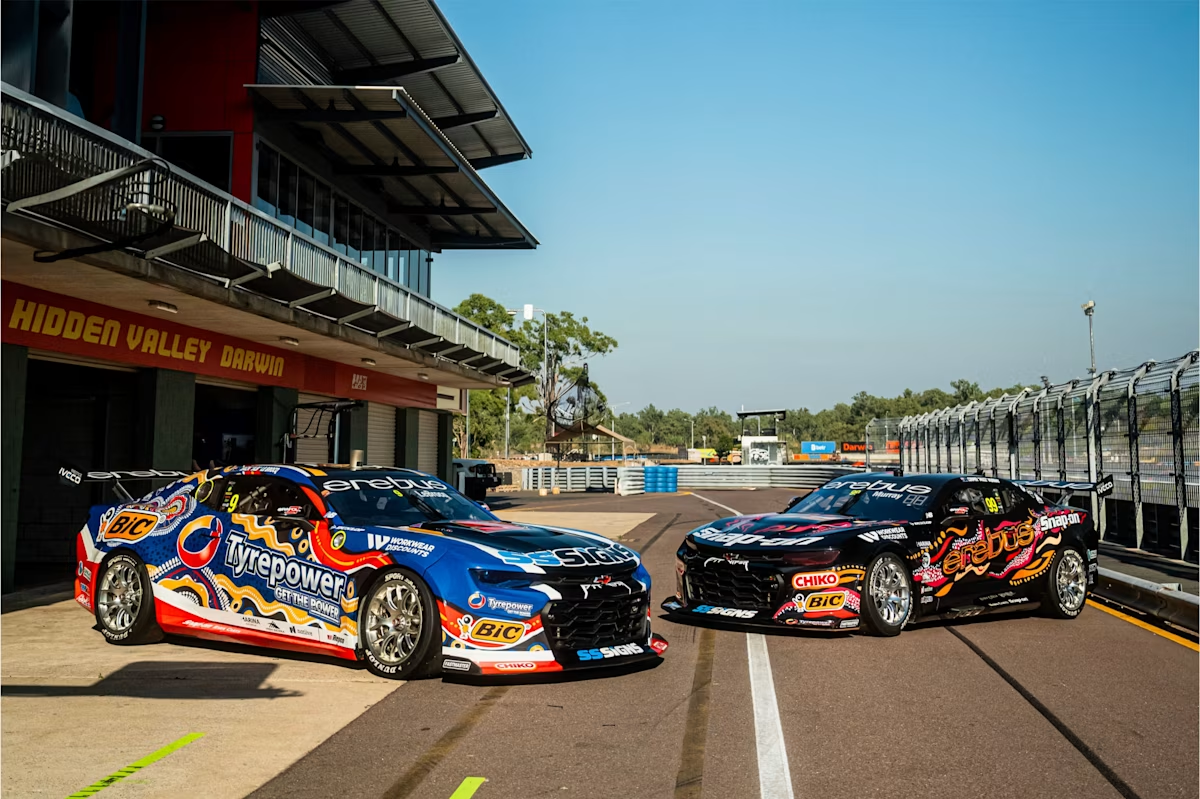
Erebus Motorsport
drivers - Jack lebroq #9 and cooper murray #99
Chevrolet Camaro ZL1
artist - Jedess Hudson
Aboriginal artist, Jedess Hudson’s, artwork once again takes pride of place on Jack Le Brocq’s #9 Camaro.
This year’s livery is more than just a design — it’s a story in motion. It celebrates strength through connection, a reminder that true power comes from deep ties to people, culture, and Country.
Circular motifs represent meeting places where stories are shared, and community grows. These shapes pulse with energy, reflecting Tyrepower’s motto: “Get the Power.” Pathways link each circle, symbolising journeys across Country and the passing of knowledge through generations. Ochre, red, gold, and white pay tribute to land, ceremony, and spiritual grounding. Jedess Hudson, a proud descendant of the Ewamian and Western Yalanji peoples of North Queensland, draws inspiration from her traditional homelands: the land, seasons, bush tucker, flora, and fauna.
Renowned for her powerful storytelling through visual art, this marks the second consecutive year Jedess’ work has featured on an Erebus Motorsport livery. Her 2024 collaboration with Le Brocq continues a growing legacy of First Nations representation in motorsport, following previous designs for Brad Jones Racing in 2022 and Tickford Racing in 2023.
The partnership between artist Jedess Hudson and Erebus motorsports continues in 2025, with Cooper Murray’s #99 car being adorned with her work, Fuelled by Fire.
The powerful Chevrolet Camaro will come alive with bursts with vibrant colour and bold movement that is inspired by fire — a symbol of passion, resilience, and transformation. While black has long defined the team’s colours and identity, shades of pink and purple take their place as a nod to team owner Betty Klimenko. The colours are a reminder that strength comes in many shades — and sometimes, it’s the boldest that burn brightest. In Aboriginal cultures, women are honoured as life-givers and protectors of story — a spirit reflected in this colour choice. Flowing lines of ochre, red, pink, and gold dance like flames, driving the team forward.
Jedess’ work continues to celebrate and elevate First Nations identity on national platforms, with a growing tradition of Indigenous culture in motorsport. This has been prevalent in her 2-year collaboration with Erebus, as well as previous livery designs for Brad Jones Racing in 2022 and Tickford Racing in 2023.

Shell V-Power Racing
Drivers - Brodie Kostecki #38 and Will Davison #17
Ford Mustang GT
artist - Kurun Warun
The artwork featured on the Shell V-Power Racing Team cars is a deeply personal creation by artist Kurun Warun (Tio), whose journey as a painter began at just eight years old, exhibiting alongside his mother.
Drawing inspiration from the natural elements of Country like slow-moving rivers, the eels that swim through them, the earth’s dust, and the life teeming in the sea, Kurun Warun’s paintings are rooted in tradition, often revealing hidden stories through layers of colour, contrast, and space.
The piece showcased on cars #38 and #17, tells a powerful story of intergenerational teaching, reflecting Kurun’s passion for family and cultural knowledge-sharing. Central to the artwork is a traditional kangaroo hunting dance, a way of passing skills from Elders to younger generations. The mother figure, marked by the shape of her breasts, is seen teaching, while behind her, Kurun’s wife and three children observe. Opposite, older community members also watch on, highlighting the collective responsibility of raising and guiding the next generation.
Every detail in the piece, from the spray of dust, seeds and local plant life to the body paint and hunting tracks, embodies the idea that when we respect the land, it provides in return.
Proudly descended from Truganini, Queen of Tasmania, and the Framlingham Mission community, Kurun Warun’s art has garnered international recognition, collected by figures such as Oprah and the Prince of Saudi Arabia. Beyond painting, he is also a talented didgeridoo player and traditional dancer who has performed across the globe.
This year’s livery is more than art on a car—it is a moving tribute to legacy, land, and the power of story.
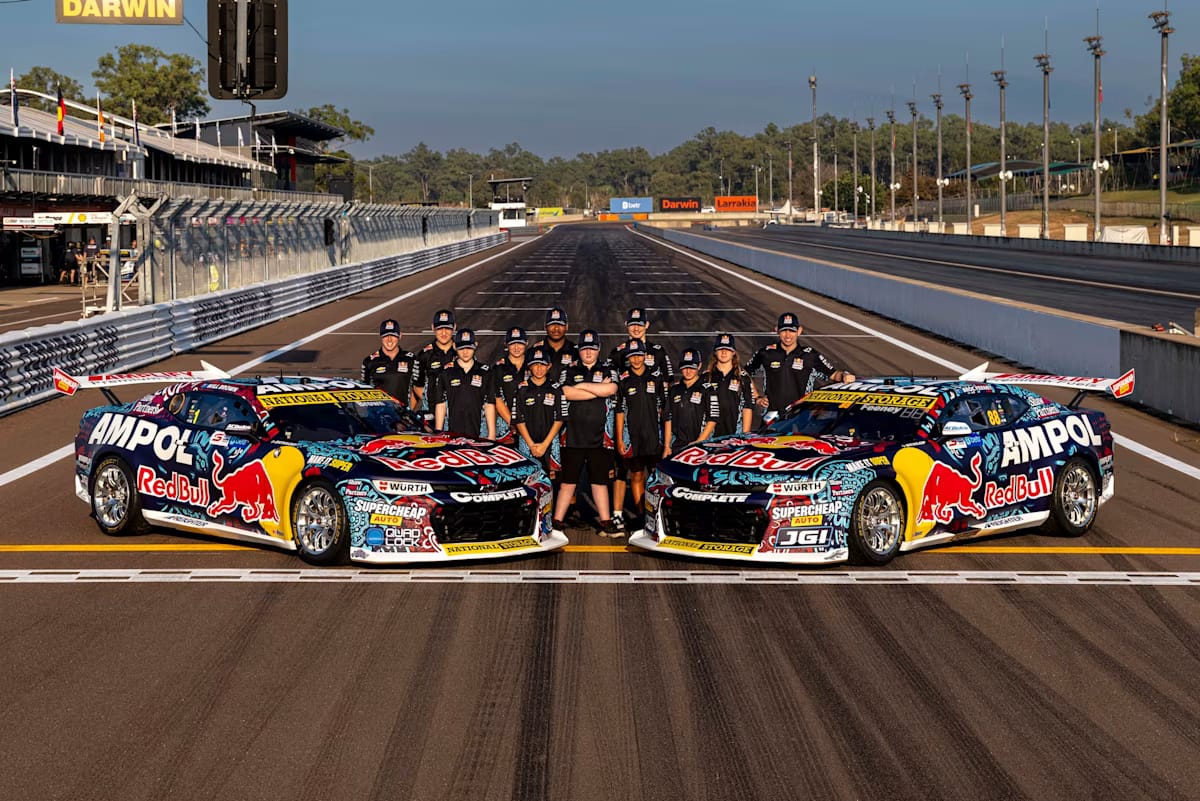
Triple 8
Drivers - Will Brown #1 and Brock Feeney #88
Chevrolet Camaro ZL1
artist - Christopher Brumby - Taminmin College
At the heart of the striking Indigenous livery design for the Triple Eight Racing’s powerful Camaros – driven by Broc Feeney (#88) and Will Brown (#1) – is a powerful celebration of Country and connection.
Envisioned by Taminmin College Year 12 student, Christopher Brumby, the artwork was created as part of the school’s Indigenous art program.
Featuring vibrant dot painting, the design captures the harmony between people, animals, and the land. Flowing blue dots represent creeks and waterholes - precious sources of life and knowledge. Red dots signify the warmth of the earth, and the deep spiritual connections shared amongst all living beings across generations.
Central to the artwork are a crocodile and a barramundi, symbolising ancient elders – the guardians of wisdom, tradition, and the natural world. The pathways weaving between waterholes reflect how people and animals walk together, guided by the stories and teachings of Country.
The design proudly reflects the Northern Territory’s rich cultural landscapes and the importance of unity, respect, and knowledge-sharing — both on and off the track.
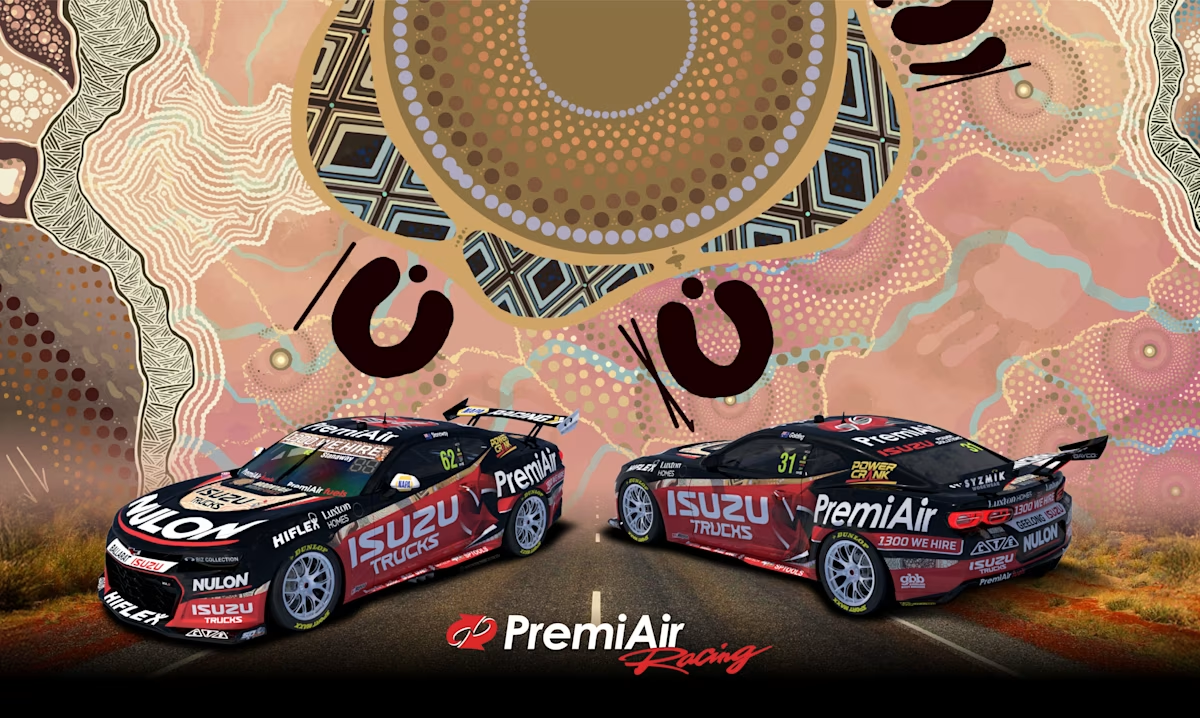
PremiAir Racing
Drivers - richie stanaway #62 and james golding #31
Chevrolet Camaro ZL1
artist - sheldon harrington
PremiAir Racing’s twin Chevrolet Camaros—driven by Richie Stanaway (#62) and James Golding (#31)—feature another striking livery created by young Widjabul artist Sheldon ‘SJ’ Harrington.
Hailing from the Bundjalung Nation on the Far North Coast of NSW, SJ blends traditional Aboriginal art with contemporary styles to honour the tradition and the evolving path of Aboriginal culture and represent Country on canvas.
Titled ‘Moonyah’ (meaning safe house, safe place), the patterns highlight the journey and enduring spirit of Moonyah Workforce, an Indigenous-owned business founded by ex-Wallaby rugby union twins Saia and Anthony Fainga’a. Moonyah stands as a place of strength, connection, and respect—where people come together to work, learn, and grow. It is a living representation of culture, purpose, and community, grounded deeply in Country and tradition.
At the heart of the design, turtle shells echo the spirit of Moonyah; a place of connection, growth, and knowledge sharing. They speak to protection, the unfolding journey of learning, and the beautifully intertwined yet distinct paths of its founders.
The bold contrast of rich black and vibrant red creates immediate visual impact, symbolising strength, and unity. Through vibrant storytelling and powerful symbolism, SJ’s work is a striking expression of identity and purpose — honouring both the collective and individual journeys that shape Moonyah’s story.
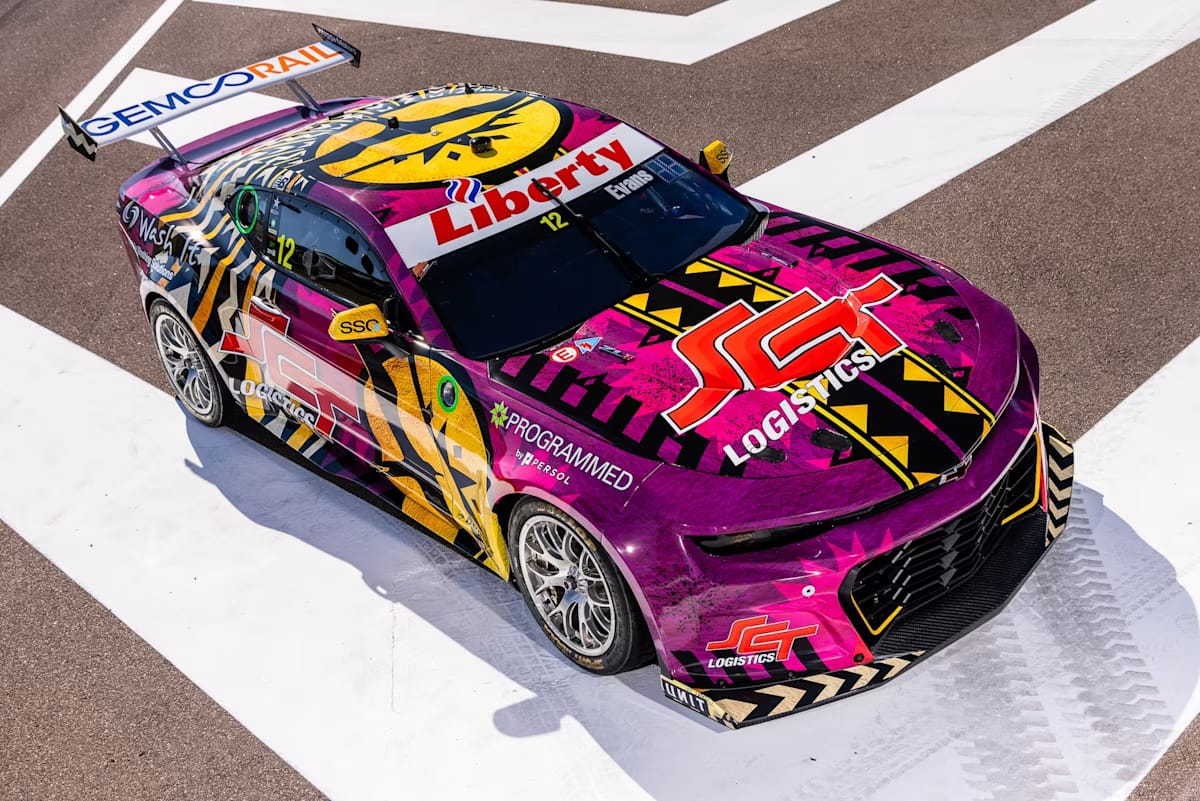
Brad Jones Racing
driver - Jaxon evans #12
Chevrolet Camaro ZL1
artist - Nakita Russell-Watling
Jaxon Evan’s Chevrolet Camaro (#12) has been proudly wrapped with a stunning livery by Fiji born artist, Nakita Russell-Watling.
The artwork, entitled Wings of the Ancestors, is a tribute to bold, modern identity rooted in the cultural richness of Rotuma, a remote island in Fiji. Dynamic and unmistakable, the piece captures the personal journey of driver Jaxon Evans who also hails from Fiji, blending athletic drive and ancestral pride with island-born elegance.
At the heart of this design soars the frigate bird — a striking symbol of freedom, resilience, and the deep pull of home. Frigate birds can stay aloft for weeks, riding ocean winds with strength and grace. They live at sea, but always return to land — a powerful metaphor for endurance, perspective, and a deep-rooted connection to home. Like Jaxon, the frigate bird travels far but is always guided by where it comes from.
Ms Russell-Watling is an artist and graphic designer, who grew up in a small town on Fiji's second largest island, Vanua Levu. The daughter of an artist and mechanic, she was raised with a love for art and cars.
Returning recently to Fiji with her young family, she co-founded Moko Club Fiji, a not-for-profit streetwear label that donates 100% of its profits to charities supporting children's futures across Fiji. Nakita continues to channel her talent and heart into work that uplifts, empowers and gives back to the community that raised her
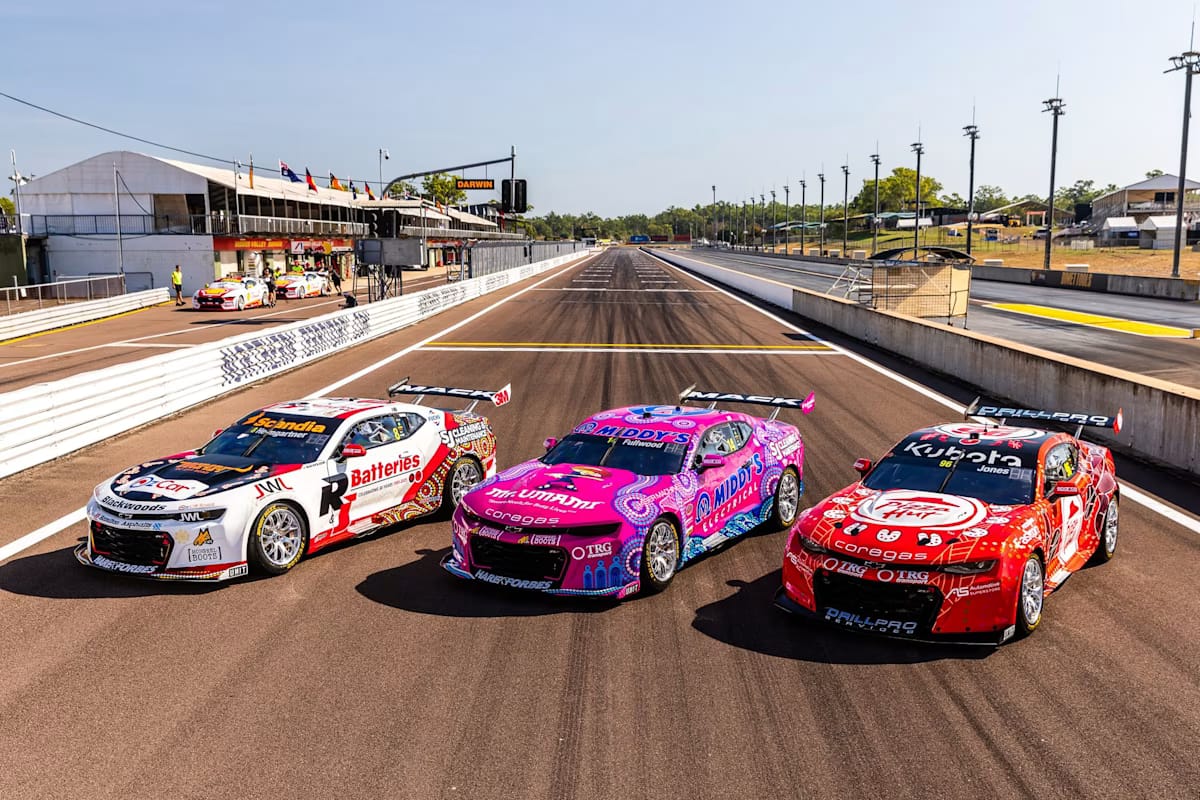
Brad Jones Racing
drivers - Andre Heimgartner #8, Bryce Fullwood #14 and Macauley Jones #96
Chevrolet Camaro ZL1
artist - Mungabareena Aboriginal Corporation
Three Brad Jones Racing cars are wrapped in bespoke liveries, each woven with the stories and symbols of four powerful Indigenous artworks. These were created by young women from Albury–Wodonga, through a meaningful collaboration between the Mungabareena Aboriginal Corporation (MAC) and the Stars Foundation.
Inspired by the 2025 NAIDOC theme, “The Next Generation: Strength, Vision & Legacy,” the artworks reflect stories of identity, culture, and connection to Country, the artists weaving meaning and legacy into each design.
Local Territory Driver, Bryce Fullwood’s #14 Camaro features four prominent symbols across the livery, identifying the Country of the artists and echoing the core themes of NAIDOC. Gracefully displayed across the front of the car are three tall symbols representing the 3 Sisters mountains - a place of sacred significance to the Gundungurra and Darug People.
The striking blue design flowing along the sides of the car represents the river at Wilcannia, while a lighter pink geometric shape maps the pathways between meeting places. Scattered throughout, flowers represent women’s business, a sacred and important aspect of Aboriginal life.
Andre Heimgartner’s #8 Camaro tells a story of connection and movement across Aboriginal lands. A series of large dot symbols trace the course of a flowing river, while footprints walk the bonnet, symbolising journeys taken, land traversed and lives interwoven.
Macauley Jones’ #96 car proudly showcases the totem of the Wiradjuri people – the Gugaa (goanna). Symbolising unity and continuity, the Gugaa wraps boldly around the car in vivid hues of red, white, and black. It is a visual representation of the past, present, and future, uniting all people on Wiradjuri land. His livery also pays tribute to the 3 Sisters and key meeting places, reinforcing the powerful ties to story and Country.
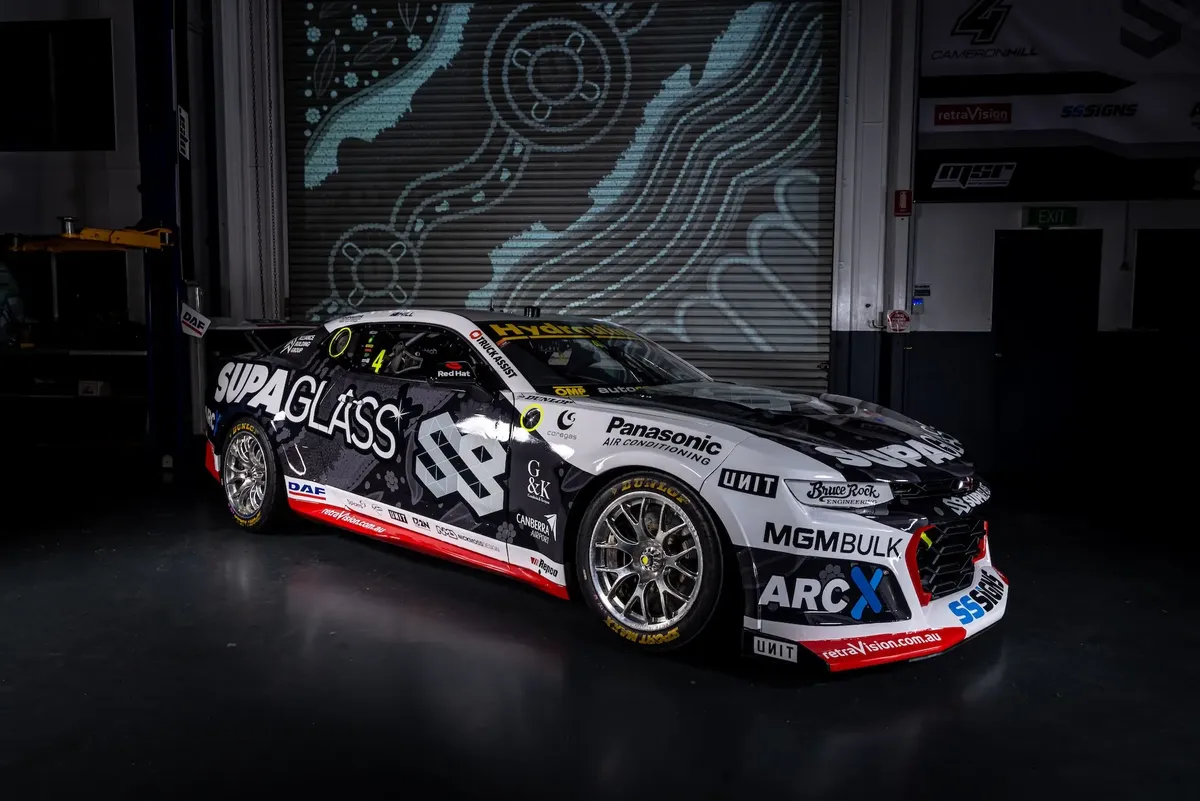
Matt Stone Racing
driver - Cameron Hill #4
Chevrolet Camaro ZL1
artist - Billy-Jay (‘BJ’) O’Toole
The enduring connection between people and Country is the inspiration behind the Indigenous livery artwork for Cameron Hill’s #4 Chevrolet Camaro. The artwork, entitled Hands and Water is by Wadawurrung man and Traditional Owner, Billy-Jay (‘BJ’) O’Toole.
Through a bold, contemporary lens, BJ brings to life the stories of his people and place. His artworks often echo the natural forms of Wadawurrung Country; the rivers, coastlines, and escarpments, and are layered with symbolism that speaks to culture, identity, and continuity.
This year’s livery is a reimagining of his original artwork, evolved with a new twist to suit the bold monochromatic palette of the Supaglass brand. The shift to black, white and grey tones gives the piece a striking clarity, amplifying both tradition and performance in unison.
The use of handprints speak to connection to land and presence, a mark of those who have walked before and those who carry knowledge forward. Subtle line and dot work across the piece reflects the coastal cliffs and dunes that hold thousands of years of cultural knowledge and story. Eucalyptus leaves with “Bunjil”, the creator of Wadawurrung country, flying overhead is a gesture of welcome, embracing travellers and teams as they move through Country.
At the heart of the design are meeting places that echo moments of gathering, learning and storytelling, connecting past to present. BJ’s livery design for the Supaglass Camaro is a stunning reimagining of traditional practices for modern engineering, bringing place and culture to life at full speed.
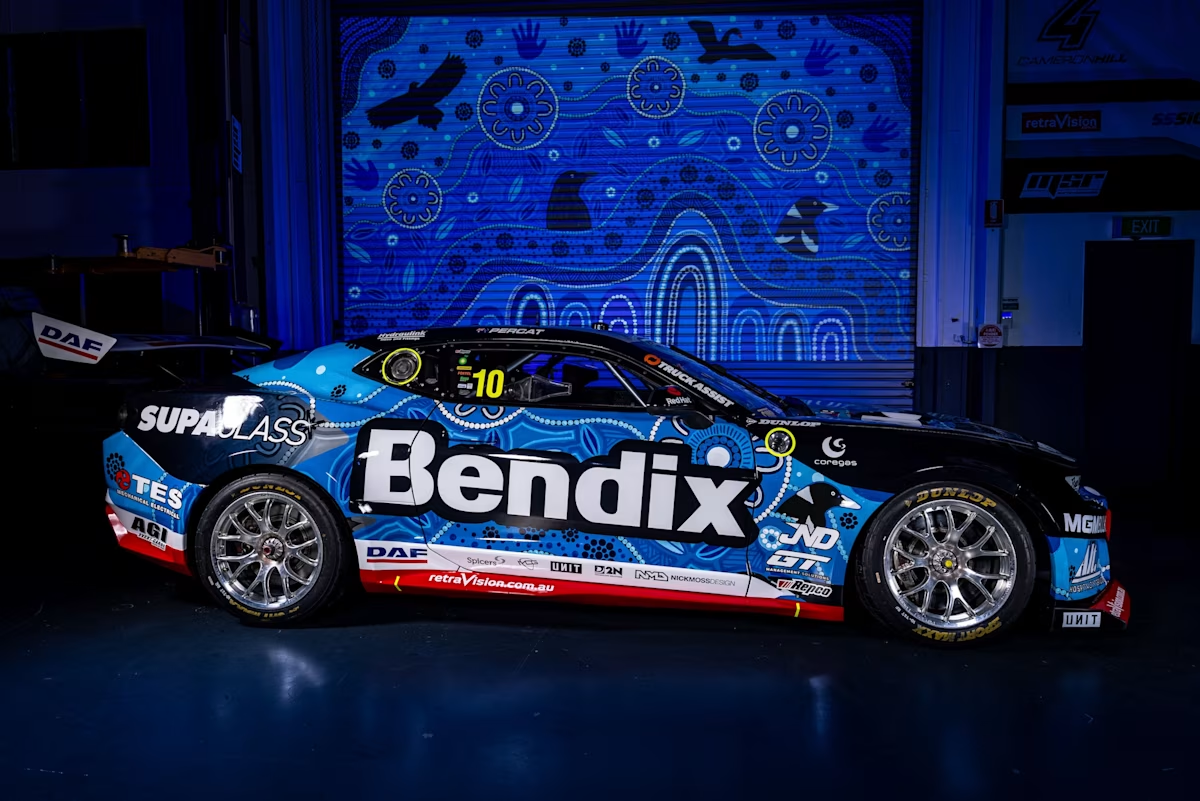
Matt Stone Racing
driver - Nick Percat #10
Chevrolet Camaro ZL1
artist - Billy-Jay (‘BJ’) O’Toole
The striking Indigenous livery on Nick Percat’s #10 Camaro returns to the grid for 2025, this time with an evolved design that expands its celebration of First Nations culture across more of the car’s body.
Created by Wadawurrung man and Traditional Owner Billy-Jay (BJ) O’Toole, the artwork is inspired by his deep connection to Wadawurrung Country, and the many Indigenous nations the Supercars Championship travels through on its way to the Darwin round. Voted ‘Best Indigenous Livery of 2024’ by fans, the design continues to turn heads with its powerful on-track impact.
Drawing from his artwork Connecting to Wadawurrung Country, the livery brings traditional Indigenous iconography to life using a bold palette of ocean-inspired blue tones that ripple across the black car, creating a powerful contrast. These striking patterns frame birds of deep cultural significance in Wadawurrung storytelling, including Bunjil the wedge-tailed eagle, Waa the crow, Kunawarra the black swan, and Pawan the magpie.
A trail of eucalyptus leaves weaving through the centre symbolises both welcoming and cleansing as Bendix moves across Country, while handprint motifs represent the people behind the brand, bringing a human connection to the story. Meeting places are used to signify the journey, mapping out the many nations passed along the Supercars circuit.
Known for his bold, contemporary style with bright, earthy tones inspired by Country, BJ channels his heritage and storytelling into artworks that celebrate culture, identity, and connection—often depicting water, mountains, and coastlines drawn from his Wadawurrung roots.
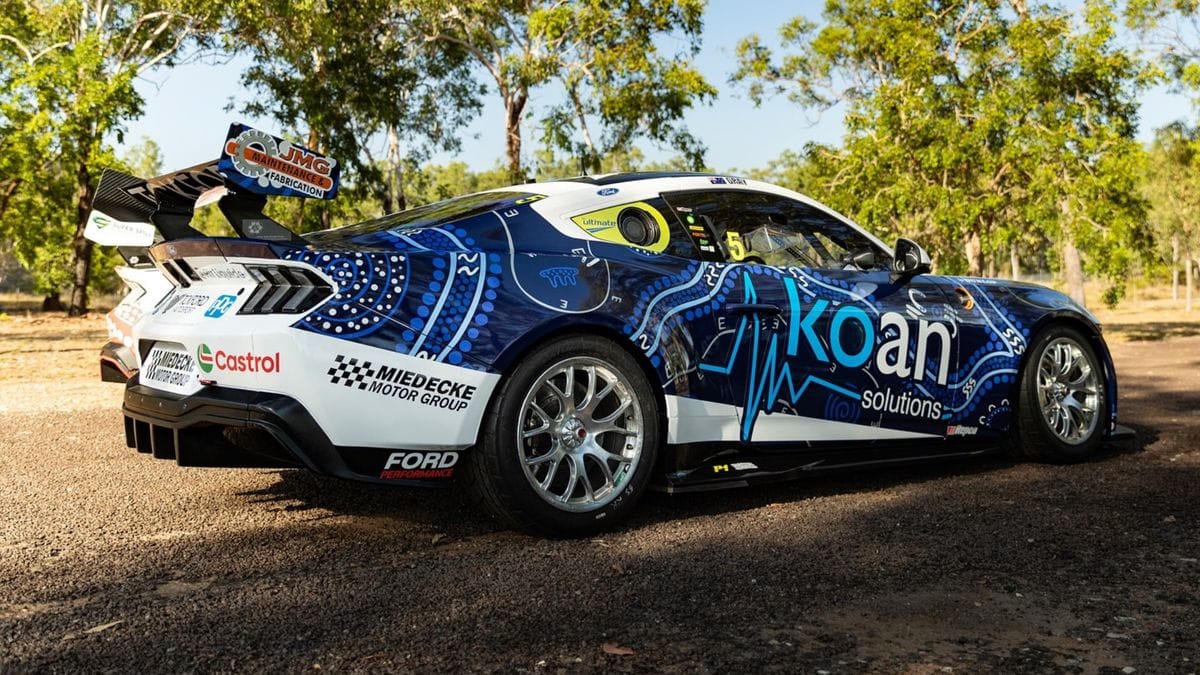
Tickford Racing
driver - Rylan Gray #5
Ford Mustang GT
artist - joshua james
A traditional Noongar dreamtime story evoking the movement of Ngangungudditj Walgu, (Rainbow Serpent) is the inspiration behind the livery design for Rylan Gray’s Ford Mustang GT. The young driver is making his Supercars debut as the wildcard driver for Tickford Racing at this year’s Indigenous round.
The artist, Joshua James, is a proud Noongar Wardandi, Bibulmun Maaman now living and working on Gulidjan Country in the South-West of Victoria. Inspired by a passion for sharing culture, his work blends traditional and contemporary design to spark conversation, connection, and truth-telling through every piece he creates.
Central to the design is the convergence of the Brunswick, Collie and Preston Rivers—connected waterways created by Walgu, a powerful ancestral being who travelled between them through underground streams and rock pools.
Symbols along the rivers mark significant cultural sites, including a pine tree used as a women’s meeting place and the Aboriginal mission by the seven hills near the Collie River. Gatherings and yarning circles reflect the strength of Noongar community and connection.
A moving tribute is woven into the design, honouring proud Noongar Elder Greg Winmar, who appears in spirit among family; his wife, children, siblings and son Laurence gathered on the riverbanks. The artwork flows with memory and movement, grounded in Country and carried forward on track to power the 18-year-old’s incredible debut under the Top End sun.

Tickford Racing
driver - Cam Waters #6
Ford Mustang GT
artist - joshua james
Indigenous artist Joshua James is the creative force behind the striking designs featured on all three Tickford Racing cars.
A proud Noongar Wardandi Bibulmun man from Noongar Boodja in Western Australia, Joshua draws inspiration from both traditional and contemporary art styles. He is deeply passionate about sharing his culture and storytelling through his work.
Far more than just a race car livery, the design of car #6 is a striking reflection of Cameron’s story—every detail is rooted in who he is, where he has come from, and what he stands for.
Born and raised in Mildura, Victoria, his roots are symbolised by the depiction of the Murray River at the base of the design. Alongside the river is a gathering motif representing Cameron’s family and friends—his steadfast support network.
Running along the top of the artwork is a visual storyline that traces Cameron’s racing career, from open-wheel carting through to success in junior motorsport ranks, the Dunlop Super2 Series, and 410 Sprint Car racing. His ambition to win a Supercars Championship is symbolised by the shield and spears—emblems of strength and resilience.
Two additional symbols hold deep personal meaning: a gathering of two figures symbolises Cameron and his role model—his father—who played a pivotal role in his racing journey.
The final symbol, a cluster of three U-shapes, represents his core values: determination, loyalty, and teamwork—principles that continue to shape him both on and off the track.
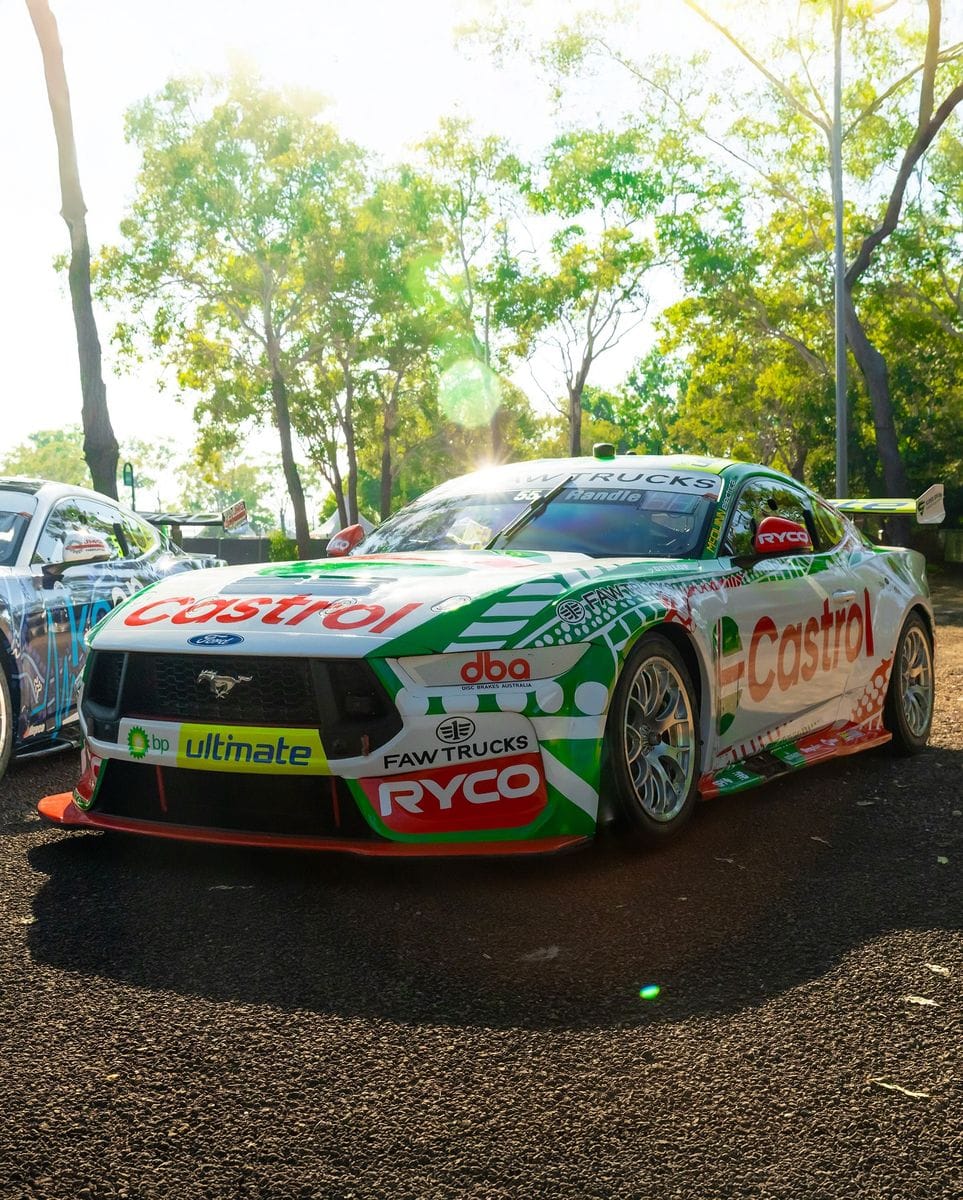
Tickford Racing
DRIVER - Thomas Randle #55
Ford Mustang GT
artist - joshua james
Celebrated Indigenous artist Joshua James brings his bold and culturally rich vision to life across all three Tickford Racing cars.
A proud Noongar Wardandi Bibulmun man from Noongar Boodja in Western Australia, Joshua is deeply passionate about using his art to share stories: “My inspiration for creating traditional and contemporary designs is Moorditj (strong) because I can share my culture, our Aboriginal voice, truth telling and storytelling all through the strength of my designs.”
As with the other Tickford Racing cars, the livery for car #55 draws on the distinctive qualities of its driver, Thomas Randle — particularly his focus and unwavering determination.
Threaded throughout the design is a form of Songline, representing Thomas’ career journey across diverse motorsport categories — from karting and Formula Renault in Europe to competing in the Supercars. Songlines are a traditional Aboriginal method of storytelling that has connected people and place for thousands of years.
The boot of the car features three unique symbols significant to Thomas. The ‘U’-shaped motifs surrounding a central circle signify a gathering of people, highlighting his connection with fans and teammates. A shield symbol represents his inner strength and fierce pursuit of victory. The dot and curved line motifs reflect the core values that drive him — perseverance, gratitude, and humility — qualities that define his racing ethos and approach to life.

